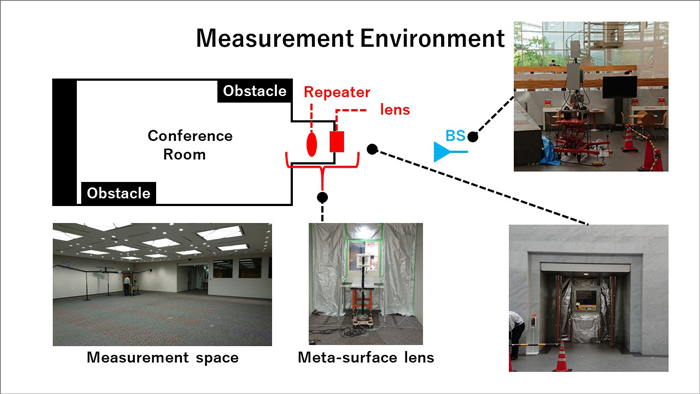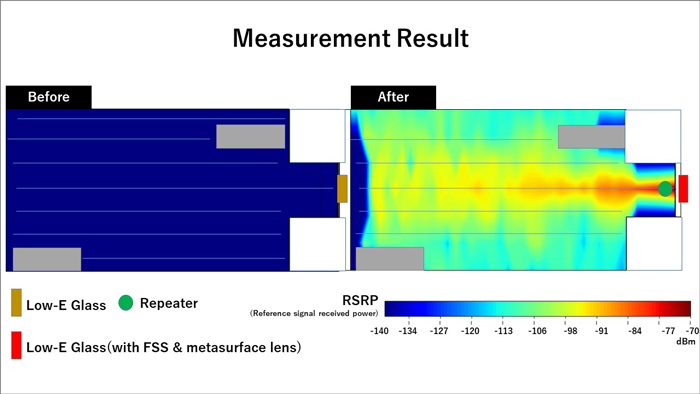#06 5G Evolution and 6G
— HAPS, metasurface lens and pinching antenna —


Expanding coverage (extending coverage area and filling coverage holes) of the superfast communications network will dramatically improve network stability and availability and may make it the cornerstone wireless technology that supports numerous 6G applications.
To realize this, we are implementing the following measures:
- Fill coverage holes using pinching antenna (cable pinched with a small piece of plastic)
- Fill coverage holes using a metasurface lens
- HAPS (significant coverage expansion using High Altitude Platform Stations)
Improving Indoor Coverage Using Pinching Antenna
Conventional technology for building mobile communication areas have not allowed for easy switching, and we have been limited to minor area adjustments set through parameters. This has made it difficult to make necessary changes to the area from on site. To address this challenge, NTT DOCOMO developed a "pinching antenna" in which a simple pinch to the cable can switch the site of wave emission, successfully developing a technology that enables on-site adjustments to the area.


Waves are transmitted along a dielectric waveguide, and this technology adopts the phenomenon that when the line is pinched with a different dielectric material, radio wave leakage occurs. Pinching at multiple points causes the pinched locations to function as antennae.


We evaluated the extent of the constructible area in a real-life setting using this technology combined with a relay device within the NTT DOCOMO R&D Center. We verified concrete area improvements in a location with multiple meeting rooms by training along dielectric waveguides, and the results show that sufficient improvements to communication quality can be achieved in each room.


Unlike conventional antennae, this technology allows for temporary construction and removal of an area. We have great hopes to see this technology applied in a wide range of new settings and will continue to improve performance and consider new applications.
Improving Indoor Coverage Using Metasurface Lens
Because higher frequencies such as millimeter waves are especially sensitive to the presence of walls, one major issue is how to simplify construction of indoor communication spaces. We were considering one possible solution to improve coverage, which is to effectively draw outside radio waves inside through a relay system.


We have been examining various "metamaterial technologies" and their use in improving communication environments, and in January 2021 developed a "metasurface lens" for application on glass surfaces. We are seeing success in developing the technology to gather radio waves from outside and draw them indoors.


We examined the results of actual coverage improvements by pairing this technology with a relay station device (Cooperation on relay device experiment: Denki Kogyo Co. Ltd.). The proof-of-concept is evaluating the extent of penetration of radio waves from a 28GHz base station installed within the NTT DOCOMO R&D Center through a glass window and into a 12 x 18 m room.


On this occasion, we confirmed that it is possible to improve indoor coverage by combining a Low-E glass with a Frequency Selective Surface(FSS)* and a metasurface lens to aggregate and amplify electromagnetic waves with a relay device. Moreover, we will proceed with assessments for overcoming a range of issues to see this through to actual implementation, including adopting metasurface lenses positioned for the different angles of various waves coming from the base station.
- Due to impact from multi-pass, etc. the aggregation effect of the lens may vary between to 5 to 20dB.


Achieving Non-terrestrial Networks using HAPS
High Altitude Platform Stations (HAPS) are closer to the earth's surface than geosynchronous satellites, making it easier to achieve higher speed communication than satellites.


(Provided by AIRBUS)
Launching HAPS with wireless devices installed makes it possible to create an area with a 50km radius from the HAPS location offering up to 10Gbps. In particular, using broadband millimeter-wave radio waves makes it possible to supply in a timely manner the high-speed, high-capacity, low latency circuits demanded in a wide range of business and event settings, irrespective of location at sea, mid-air, or in isolated sites. HAPS also has applications for public safety in times of disaster.


DOCOMO has created a HAPS simulator to support interference reduction and frequency sharing.
This simulator visualizes various possible uses of HAPS and then has a function to estimate throughputs based on each simulated usage.


We will continue with our validation and conduct feasibility studies to demonstrate concrete results.
Partner Company
DOWNLOAD

Download materials about the exhibits here.
![]() 5G Evolution and 6G — HAPS, metasurface lens and pinching antenna — (ZIP:2MB)
5G Evolution and 6G — HAPS, metasurface lens and pinching antenna — (ZIP:2MB)





